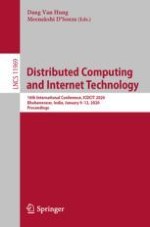This book constitutes the proceedings of the 16th International Conference on Distributed Computing and Internet Technology, ICDCIT 2020, held in Bhubaneswar, India, in January 2020. The 20 full and 3 short papers presented in this volume were carefully reviewed and selected from 110 submissions. In addition, the book included 6 invited papers. The contributions were organized in topical sections named: invited talks; concurrent and distributed systems modelling and verification; cloud and grid computing; social networks, machine learning and mobile networks; data processing and blockchain technology; and short papers.
